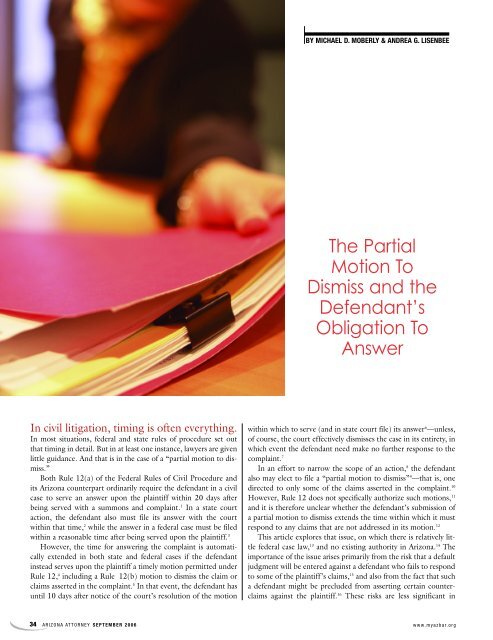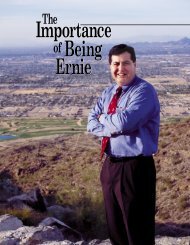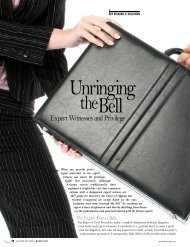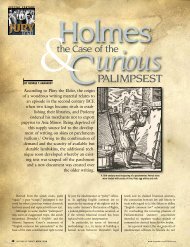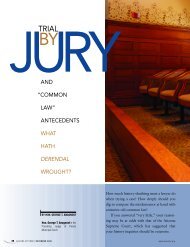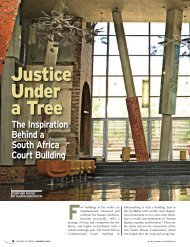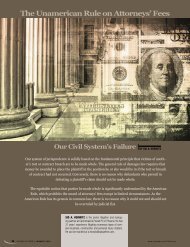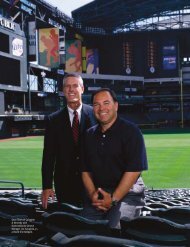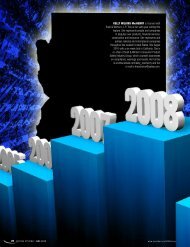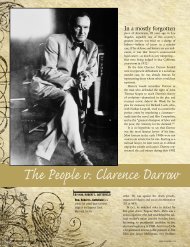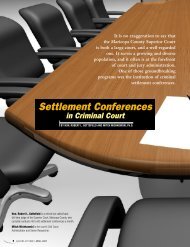The Partial Motion To Dismiss and the Defendant's ... - Lawyers
The Partial Motion To Dismiss and the Defendant's ... - Lawyers
The Partial Motion To Dismiss and the Defendant's ... - Lawyers
You also want an ePaper? Increase the reach of your titles
YUMPU automatically turns print PDFs into web optimized ePapers that Google loves.
<strong>The</strong> <strong>Partial</strong> <strong>Motion</strong> <strong>To</strong><strong>Dismiss</strong> <strong>and</strong> <strong>the</strong>Defendant’s Obligation<strong>To</strong> Answer—continued from p. 36endnotes1. See FED.R.CIV.P. 12(a)(1)(a); ARIZ.R.CIV.P.12(a)(1)(a).2. See ARIZ.R.CIV.P. 12(a)(1)(a).3. See FED.R.CIV.P. 5(d); Katz v. Morgenthau,709 F. Supp. 1219, 1226 (S.D.N.Y.), aff’din part <strong>and</strong> rev’d in part, 892 F.2d 20 (2dCir. 1989); Madden v. Clel<strong>and</strong>, 105 F.R.D.520, 525 (N.D. Ga. 1985).4. See FED.R.CIV.P. 12(a)(4); ARIZ.R.CIV.P.12(a)(3); Goff v. Superior Courts, 409 P.2d60, 64 (Ariz. Ct. App. 1965).5. See Ju Shu Cheung v. Dulles, 16 F.R.D. 550,552 (D. Mass. 1954); State v. $5,500.00 inU.S. Currency, 817 P.2d 960, 962-63(Ariz. Ct. App. 1991).6. See Milk Drivers, Local Union 387 v. RobertsDairy, 219 F.R.D. 151, 152 (S.D. Iowa2003); Northl<strong>and</strong> Ins. Cos. v. Blaylock, 115F. Supp. 2d 1108, 1115 (D. Minn. 2000);$5,500.00 in U.S. Currency, 817 P.2d at962 & n.6.7. See Ritts v. Dealers Alliance Credit Corp.,989 F. Supp. 1475, 1480 (N.D. Ga.1997); Poe v. Cristina Copper Mines, Inc.,15 F.R.D. 85, 86 (D. Del. 1953).8. See Texas Taco Cabana, L.P. v. Taco Cabanaof N.M., Inc., 304 F. Supp. 2d 903, 907(W.D. Tex. 2003) (observing that “amotion to dismiss provides a valuable toolfor narrowing <strong>and</strong> clarifying <strong>the</strong> scope oflitigation”).9. See Drewett v. Aetna Cas. & Sur. Co., 405F. Supp. 877, 878 (W.D. La. 1975)(“Authorities indicate that [a Rule12(b)(6)] motion [directed to <strong>the</strong> failureto state a claim upon which relief can begranted] may be used to challenge <strong>the</strong> sufficiencyof part of a pleading such as a singlecount or claim for relief.”) (citationomitted); cf. Elliott v. State Farm Mut.Auto. Ins. Co., 786 F. Supp. 487, 489(E.D. Pa. 1992) (“A Rule 12(b)(6)motion may be granted as to portions of acomplaint.”).10. See, e.g., Capresecco v. Jenkintown Borough,261 F. Supp. 2d 319, 321 (E.D. Pa. 2003)(“Defendants filed <strong>the</strong>ir <strong>Motion</strong> to <strong>Dismiss</strong>pursuant to Fed.R.Civ.P. 12(b)(6),although <strong>the</strong> Court notes that Defendants’<strong>Motion</strong> is in <strong>the</strong> nature of a <strong>Partial</strong> <strong>Motion</strong>to <strong>Dismiss</strong>, because <strong>the</strong>y only attack portionsof Plaintiff’s claims.”); cf. Wade v.United States, 745 F. Supp. 1573, 1575(D. Haw. 1990) (observing that a motionto dismiss addressing only some of <strong>the</strong>plaintiff’s claims “is properly characterizedas one for partial dismissal”).11. Although <strong>the</strong> rule itself is silent on <strong>the</strong>matter, “No reported decision hasexpressed doubt over <strong>the</strong> propriety of apartial motion to dismiss.” Scott L. Cagan,A “<strong>Partial</strong>” <strong>Motion</strong> to <strong>Dismiss</strong> UnderFederal Rule of Civil Procedure 12: Youwww.myazbar.org SEPTEMBER 2006 ARIZONA ATTORNEY 59
endnotes continuedHad Better Answer, 39 FED. B. NEWS & J.202, 202 (1992).12. See Gerlach v. Michigan Bell Tel. Co., 448 F.Supp. 1168, 1174 (E.D. Mich. 1978)(“F.R.C.P. 12 does not explicitly address <strong>the</strong>issue of whe<strong>the</strong>r <strong>the</strong> filing of a motion underF.R.C.P. 12(b) … alters <strong>the</strong> time withinwhich <strong>the</strong> moving party must respond toclaims in <strong>the</strong> complaint not addressed in <strong>the</strong>motion.”).13. See Oil Express Nat’l, Inc. v. D’Aless<strong>and</strong>ro,173 F.R.D. 219, 220 (N.D. Ill. 1997)(“Whe<strong>the</strong>r a party is required to answerunchallenged counts after a Rule 12(b)motion has been filed as to certain, but notall, of <strong>the</strong> counts is an issue that has notreceived significant judicial attention.”).14. Arizona is not <strong>the</strong> only state in which thisissue is unsettled. See, e.g., Nelson G. Apjohn& Patrick F. Brady, Dispositive <strong>Motion</strong>s,MASSACHUSETTS SUPERIOR COURT CIVILPRACTICE MANUAL § 6.2.1(b) practice note(Supp. 2002) (“<strong>The</strong> rules do not addresswhe<strong>the</strong>r a defendant who has moved to dismissonly some claims of a multicount complaintmust file an answer with respect to <strong>the</strong>remaining counts within <strong>the</strong> 20-day periodof Mass.R.Civ.P. 12(a). … [N]oMassachusetts decision addresses thisissue.”).15. See Cagan, supra note 11, at 202 (observingthat “practitioners … risk a default judgmentif <strong>the</strong>y do not answer <strong>the</strong> unchallengedcounts of <strong>the</strong> complaint in <strong>the</strong> event <strong>the</strong>y filea partial motion to dismiss”).16. <strong>The</strong> prevailing view in both <strong>the</strong> federal <strong>and</strong>Arizona state courts is that a default judgmentprecludes <strong>the</strong> defendant from subsequentlyasserting against <strong>the</strong> plaintiff a claimthat would have constituted a compulsorycounterclaim in <strong>the</strong> case in which <strong>the</strong> defaultjudgment was entered. See Lindquist v.Quinones, 79 F.R.D. 158, 161 (D.V.I.1978); Rich v. Tudor, 599 P.2d 846, 848(Ariz. Ct. App. 1979). As <strong>the</strong> ArizonaSupreme Court has explained:A default judgment has <strong>the</strong> same res judicataeffect as a judgment on <strong>the</strong> meritswhere <strong>the</strong> issues were litigated. We wouldcircumvent <strong>the</strong> purpose of Rule 13(a) ifwe were to rule that a claim which was<strong>the</strong> subject of a compulsory counterclaimis not barred in a subsequent suit merelybecause judgment was taken by defaultra<strong>the</strong>r than on <strong>the</strong> merits.Technical Air Prods., Inc. v. Sheridan-Gray,Inc., 445 P.2d 426, 428 (Ariz. 1968).17. Rule 55(a) of <strong>the</strong> Arizona Rules of CivilProcedure “requires that notice of <strong>the</strong> applicationfor entry of default shall be given to<strong>the</strong> party claimed to be in default.” State exrel. Corbin v. Marshall, 778 P.2d 1325, 1327(Ariz. Ct. App. 1989) (discussingARIZ.R.CIV.P. 55(a)). <strong>The</strong> rule <strong>the</strong>n permits<strong>the</strong> party in default to file an answer within a10-day “grace period,” in which event “<strong>the</strong>clerk’s entry of default never takes effect.”Corbet v. Superior Court, 798 P.2d 383, 385(Ariz. Ct. App. 1990). <strong>The</strong> rule thus “essentiallyextends <strong>the</strong> time to answer under Rule12(a)” by enabling a defendant to berelieved of its default “simply by filing ananswer within <strong>the</strong> 10-day grace period.”Gen. Elec. Capital Corp. v. Osterkamp, 836P.2d 398, 402 (Ariz. Ct. App. 1992).18. If <strong>the</strong> defendant in a federal case “fails to filean answer in response to a complaint, <strong>and</strong><strong>the</strong> plaintiff notifies <strong>the</strong> Court, <strong>the</strong>n <strong>the</strong>Clerk must enter default against that defendant.”Kingvision Pay-Per-View Ltd. v. Niles,150 F. Supp. 2d 188, 190 (D. Me. 2001)(citing FED.R.CIV.P. 55(a)). Once thatoccurs, “no responsive pleading may bemade … unless <strong>the</strong> Defendant formallymoves to set aside <strong>the</strong> entry of default.”Maryl<strong>and</strong> Nat’l Bank v. M/V Tanicorp I, 796F. Supp. 188, 190 (D. Md. 1992); see alsoKingvision Pay-Per-View, 150 F. Supp. 2d at189 (“[O]nce default has been entered, <strong>the</strong>only appropriate response for a defendant tomake is a motion to set aside default.”). It isalso “hornbook law that once default hasbeen entered by <strong>the</strong> Clerk, only <strong>the</strong> Court isempowered to set it aside,” LoperenaHern<strong>and</strong>ez v. Hern<strong>and</strong>ez, 107 F.R.D. 102,104 (D.P.R. 1985), <strong>and</strong> it may do so “only… upon a showing of ‘good cause.’”Kingvision Pay-Per-View, 150 F. Supp. 2d at190 (citing FED.R.CIV.P. 55(c)).19. 448 F. Supp. 1168 (E.D. Mich. 1978).20. See id. at 1174 (“[T]here appears to be nocase law which addresses this issue.”); see alsoBull HN Info. Sys., Inc. v. American ExpressBank Ltd., 1990 Copyright L. Dec. (CCH) 26,555, at 23,280 (S.D.N.Y. 1990)(describing Gerlach as “<strong>the</strong> only case onpoint”).21. See Gerlach, 448 F. Supp. at 1170. In federalcases, obtaining a default judgment is “atwo-step process.” New York v. Green, 420F.3d 99, 104 (2d Cir. 2005). First, “[t]heClerk of Court is authorized to enter defaultwhen ‘a party against whom a judgment foraffirmative relief is sought has failed to pleador o<strong>the</strong>rwise defend.’” Ritts, 989 F. Supp. at1479 (quoting FED.R.CIV.P. 55(a)). In <strong>the</strong>second step of <strong>the</strong> process, “a default judgmentmay be obtained only by application to<strong>the</strong> court.” Pinaud v. County of Suffolk, 52F.3d 1139, 1152 n.11 (2d Cir. 1995) (quoting6 JAMES W. MOORE ET AL., MOORE’SFEDERAL PRACTICE 55.03[2], at 55-21 (2ded. 1994)).22. Gerlach, 448 F. Supp. at 1174.23. Id.; cf. Riddle v. Egensperger, 266 F.3d 542,551 (6th Cir. 2001) (discussing <strong>the</strong> use of aRule 12(b) motion “to narrow <strong>the</strong> claims at<strong>the</strong> onset of <strong>the</strong> case, ra<strong>the</strong>r than engagingin extensive discovery”).24. See Finnegan v. University of Rochester Med.Ctr., 180 F.R.D. 247, 249-50 (W.D.N.Y.1998) (“Gerlach … appears to be in <strong>the</strong>minority among <strong>the</strong> courts that haveaddressed this issue.”).25. Gerlach, 448 F. Supp. at 1174.26. 397 F. Supp. 63 (S.D.N.Y. 1975).27. Id. at 64.28. See Cagan, supra note 11, at 203 (notingthat <strong>the</strong> Business Incentives court reached itsconclusion “without explanation”).29. See, e.g., Oil Express Nat’l, 173 F.R.D. at221 (relying on Business Incentives in holdingthat “a partial motion to dismiss allowsfor altering <strong>the</strong> [time] limits of FED.R.CIV.P.12(a) with respect to answering those claimsnot addressed in [<strong>the</strong>] motion”).30. See Tingley Sys., Inc. v. CSC Consulting, Inc.,152 F. Supp. 2d 95, 122 (D. Mass. 2001)(“Since <strong>the</strong> issuance of <strong>the</strong> Gerlach decision,no court has relied on its reasoning or followedits ruling.”).31. See, e.g., Godlewski v. Affiliated ComputerServs., Inc., 210 F.R.D. 571, 572 (E.D. Va.2002) (“<strong>The</strong> Gerlach court’s resolution of<strong>the</strong> issue under <strong>the</strong> minority approach is, inthis Court’s opinion, unnecessarily formalisticat <strong>the</strong> expense of sound policy <strong>and</strong> judicialeconomy.”).32. See Bull HN Info. Sys., 1990 Copyright L.Dec. (CCH) 26,555, at 23,280 (relyingon Gerlach in suggesting that Rule 12(a)requires a defendant “to move or answer asto each count” of <strong>the</strong> complaint).33. See Oil Express Nat’l, 173 F.R.D. at 221;Brocksopp Eng’g, Inc. v. Bach-Simpson Ltd.,136 F.R.D. 485, 486-87 (E.D. Wis. 1991).34. See Oil Express Nat’l, 173 F.R.D. at 221;Brocksopp Eng’g, 136 F.R.D. at 487.35. See Ritts, 989 F. Supp. at 1480:[I]f a Rule 12(b) motion is granted, it willlead to dismissal of <strong>the</strong> action <strong>and</strong> <strong>the</strong>party who filed it will never have to file aresponse. In such an instance, <strong>the</strong>refore, …it makes sense not to make <strong>the</strong> party file ananswer until <strong>the</strong> Rule 12 motion isresolved.36. See Rawson v. Royal Maccabees Life Ins. Co.,No. 93 C 6866, 1994 WL 9638, at *1(N.D. Ill. Jan. 11, 1994) (“<strong>The</strong> difficulty isthat, [even] if <strong>the</strong> motion is granted, it willstill be necessary for <strong>the</strong> defendant to servean answer to <strong>the</strong> remaining claims of <strong>the</strong>complaint.”).37. See Cagan, supra note 11, at 204 (“[T]hepotential for piecemeal pleadings[] can bealleviated by <strong>the</strong> simple filing of an amendedanswer upon <strong>the</strong> disposition of <strong>the</strong> motion.With today’s computer technology, amendingan answer is hardly a cumbersometask.”) (emphasis omitted).38. See, e.g., Katt v. N.Y.C. Police Dep’t, No. 95Civ. 8283 (LMM), 1997 WL 394593, at *2n.2 (S.D.N.Y. July 14, 1997) (noting that<strong>the</strong> plaintiff’s assertion of multiple claims“caused substantial disagreement among <strong>the</strong>parties about <strong>the</strong> scope of discovery withrespect to <strong>the</strong> various claims,” which resultedin “time-consuming motion practicerelating to <strong>the</strong> proper scope of discovery”).39. Compare Weiss v. Int’l Bhd. of Elec. Workers,729 F. Supp. 144, 148 (D.D.C. 1990)(“[T]he Court stayed discovery pending aruling on defendants’ partial motion to dismiss.”)with Powell v. City of Chicago, 94 F.Supp. 2d 942, 946 (N.D. Ill. 2000):<strong>The</strong> court’s decision to allow plaintiff togo forward rests in part on <strong>the</strong> fact that60 ARIZONA ATTORNEY SEPTEMBER 2006www.myazbar.org
<strong>the</strong> instant partial motion to dismisswould not dispose of <strong>the</strong> entire case.Because <strong>the</strong> parties will have to conductdiscovery regardless of <strong>the</strong> outcome of<strong>the</strong> instant motion, it would be prematureto bar plaintiff at this early stagefrom [proceeding].40. See Chudasama v. Mazda Motor Corp., 123F.3d 1353, 1367 (11th Cir. 1997) (“Facialchallenges to <strong>the</strong> legal sufficiency of a claimor defense, such as a motion to dismissbased on failure to state a claim for relief,should … be resolved before discoverybegins.”) (footnote omitted).41. Id. at 1368.42. In most jurisdictions, <strong>the</strong> filing of a motionto dismiss under Rule 12(b) does not automaticallystay discovery pending resolutionof <strong>the</strong> motion. See In re Sulfuric Acid,Antitrust Litig., 231 F.R.D. 331, 336 &n.5 (N.D. Ill. 2005). Never<strong>the</strong>less, “suchstays are granted with substantial frequency,”id. at 336, <strong>and</strong> are clearly appropriate“where <strong>the</strong> likelihood that such motionmay result in a narrowing … of discoveryoutweighs <strong>the</strong> likely harm to be producedby <strong>the</strong> delay.” 19th Street Baptist Church v.St. Peters Episcopal Church, 190 F.R.D.345, 349 (E.D. Pa. 2000) (internal quotationmarks <strong>and</strong> citation omitted).43. See Godlewski, 210 F.R.D. at 572 (“[T]heminority approach has <strong>the</strong> advantage ofpreventing a party from using a partialRule 12(b) motion to delay adjudication of<strong>the</strong> remaining portion of <strong>the</strong> action.”);Cagan, supra note 11, at 204 (“[R]equiringa defendant to answer <strong>the</strong> unchallengedcounts discourages <strong>the</strong> filing of a partialmotion to dismiss solely as a dilatory tactic,<strong>and</strong> encourages expedient discovery.”).44. See Cagan, supra note 11, at 204 (“A partialmotion to dismiss often has <strong>the</strong> practicaleffect of impeding, often paralyzing, <strong>the</strong>progress of discovery, <strong>and</strong> <strong>the</strong> Rules contemplatea steady—if not swift—discoverypace.”); cf. Washington v. City of Evanston,535 F. Supp. 638, 639 n.2 (N.D. Ill.1982) (“Like <strong>the</strong> large majority of [Rule]12(b)(6) motions, in principal part this onehas accomplished little except to delay <strong>the</strong>real commencement of litigation.”).45. Indeed, <strong>the</strong> filing of a motion to dismisssuspends <strong>the</strong> time for answering only if aspecific time for doing so is not o<strong>the</strong>rwise“fixed by court order.” FED.R.CIV.P.12(a)(4). Thus, a court clearly could avoidany prejudicial delay simply by requiring<strong>the</strong> defendant to file an answer despite itssubmission of a partial motion to dismiss.See, e.g., In re Longhorn Secs. Litig., 573 F.Supp. 255, 263 (W.D. Okla. 1983) (“<strong>To</strong>expedite this litigation, … <strong>the</strong> Court hasrequired <strong>the</strong> defendants to answer <strong>the</strong>complaints even though <strong>the</strong>ir pre-answermotions were still under consideration.”).46. See, e.g., Godlewski, 210 F.R.D. at 572-73([“[A]ny potential abuses or dilatory tacticswhich <strong>the</strong> minority approach seeks to preventcan … be guarded against under <strong>the</strong>www.myazbar.org SEPTEMBER 2006 ARIZONA ATTORNEY 61
endnotes continuedmajority approach through <strong>the</strong> use of Rule11 sanctions to deter abuse.”).47. See generally Finnegan, 180 F.R.D. at 249(“[T]he language of Rule 12 itself does notsupport [<strong>the</strong> minority] position.”); BullHN Info. Sys., 1990 Copyright L. Dec.(CCH) 26,555, at 23,280 (observing thatrequiring <strong>the</strong> defendant to answer claimsnot addressed in a partial motion to dismiss“is not required by <strong>the</strong> plain language” ofRule 12(a)).48. See Ricciuti v. N.Y.C. Transit Auth., No.90, Civ. 2823 (CSH), 1991 WL 221110, at*2 (S.D.N.Y. Oct. 3, 1991) (“Any motion,particularly when <strong>the</strong> motion addresses asignificant portion of <strong>the</strong> complaint …, willsuspend <strong>the</strong> time to answer any claim.”);Merchants Nat’l Bank v. Safrabank(California), No. 90-4194-R, 1991 WL173784, at *1 (D. Kan. Aug 28, 1991)(“Ordinarily, a defendant need not file ananswer until ten days after <strong>the</strong> court hasruled on any motions permitted by Rule12.”).49. See Sellers v. Henman, 41 F.3d 1100, 1101(7 th Cir. 1994) (“Rule 12(a)(4) allows aparty that files a motion to strike a pleadingto delay filing his responsive pleading untilten days after <strong>the</strong> motion is denied . . ..”); Fredrick v. Clark, 587 F. Supp. 789,791 (W.D. Wis. 1984) (observing that <strong>the</strong>motions that enlarge <strong>the</strong> time for answeringunder Rule 12(a) “are, of course, listed inRule 12(b) through (f)”). But see 5BCHARLES ALAN WRIGHT & ARTHUR R.MILLER, FEDERAL PRACTICE & PROCEDURE§ 1346, at 46-47 (3d ed. 2004) (observingthat <strong>the</strong> “extension of time provision inRule 12(a) does not apply to <strong>the</strong> grant of amotion to strike under Rule 12(f),”although <strong>the</strong> rule’s “failure to deal with thissituation probably is simply an unintendedomission”) (emphasis added).50. See, e.g., Johnson Enters. of Jacksonville, Inc.v. FPL Group, Inc., 162 F.3d 1290, 1332n.92 (11th Cir. 1998) (discussing <strong>the</strong>defendants’ “Rule 12(f) motion to strikesome of <strong>the</strong> general allegations from <strong>the</strong>complaint”); Bureerong v. Uvawas, 922 F.Supp. 1450, 1478 (C.D. Cal. 1996)(“Under Rule 12(f), Defendants seek tostrike several items from <strong>the</strong> Complaint.”);cf. Battle v. Nat’l City Bank of Clevel<strong>and</strong>,364 F. Supp. 416, 419 (N.D. Ohio 1973)(“Ordinarily an entire pleading should notbe stricken, but only those portions, if any,which are objectionable.”).51. See, e.g., Rawson, 1994 WL 9638, at *1(noting that <strong>the</strong> rule “does not require that<strong>the</strong> motion go to all of <strong>the</strong> claims in a complaint”);United States v. Union Corp., 194F.R.D. 223, 233-34 (E.D. Pa. 2000):A party moving under Rule 12(b)(6)may challenge <strong>the</strong> sufficiency of one,some, or all of <strong>the</strong> claims for relief containedin a pleading; <strong>the</strong> overall action isnot directly at issue. . . . Nothing in <strong>the</strong>language of [<strong>the</strong>] rule suggests that itseffect <strong>and</strong> application should turn onwhe<strong>the</strong>r only one or some claims … or<strong>the</strong> entire action is at issue.52. See Wray v. Edward Blank Assocs., Inc., 924F. Supp. 498, 501 (S.D.N.Y. 1996)(“Technically, motions to strike are notproper methods of disposing of part or allof a complaint. However, to avoid beingrestricted by <strong>the</strong> technical form of commonlawpractice, which <strong>the</strong> federal rules haveab<strong>and</strong>oned, courts may treat motions tostrike as motions to dismiss.”) (citationomitted).53. Indeed, because “<strong>the</strong> essential functions of amotion to strike <strong>and</strong> a motion to dismiss arepractically identical,” Ham v. Aetna Life Ins.Co., 283 F. Supp. 153, 154 (N.D. Okla.1968), a court could elect to treat a partialmotion to dismiss “as a motion to strike ordismiss certain paragraphs of [<strong>the</strong>] plaintiff’scomplaint.” Stoutt v. S. Bell Tel. & Tel.Co., 598 F. Supp. 1000, 1001 (S.D. Fla.1984) (emphasis omitted); cf. Belton v. AirAtlanta, Inc., 647 F. Supp. 28, 28-29 n.2(N.D. Ga. 1986) (observing that a “motionto strike portions of [a] plaintiff’s complaint”is “similar in effect to a motion todismiss”).54. See Godlewski, 210 F.R.D. at 572; Finnegan,180 F.R.D. at 249; Oil Express Nat’l, 173F.R.D. at 220.55. See Finnegan, 180 F.R.D. at 249; OilExpress Nat’l, 173 F.R.D. at 220.56. See Godlewski, 210 F.R.D. at 572 (“Case law… fails to conclusively decide <strong>the</strong> issue.”).57. See Josh Belinfante, <strong>To</strong> Answer or Not toAnswer: <strong>The</strong> <strong>Partial</strong> <strong>Motion</strong> to <strong>Dismiss</strong>, 52FED. LAW. 20, 20-21 (Nov./Dec. 2005)(contrasting <strong>the</strong> minority view representedby Gerlach with <strong>the</strong> majority view embracedby courts in nine states o<strong>the</strong>r than Arizona).58. <strong>The</strong> Gerlach court itself concluded thatdefault was too “harsh” a penalty for <strong>the</strong>defendant’s failure to submit an answer, <strong>and</strong>gave <strong>the</strong> defendant 10 days from <strong>the</strong> date ofits ruling on <strong>the</strong> defendant’s partial motionto dismiss within which to submit ananswer. Gerlach, 448 F. Supp. at 1174; seealso Bull HN Info. Sys., 1990 Copyright L.Dec. (CCH) 26,555, at 23,280 (observingthat <strong>the</strong> entry of a default judgmentwould be a “very harsh remedy” for adefendant’s failure to answer claims thatwere not addressed in its motion to dismiss).59. See, e.g., Schwartz v. Berry Coll., Inc., 74Fair Empl. Prac. Cas. (BNA) 999, 1000(N.D. Ga. 1997):Significant case law <strong>and</strong> one of <strong>the</strong> mostauthoritative treatises on Federal Practice<strong>and</strong> Procedure supports Defendants’position that, when a defendant files aRule 12(b)(6) motion to dismiss,addressing only some of <strong>the</strong> claims containedin <strong>the</strong> plaintiff’s complaint, <strong>the</strong>defendant is not required to file ananswer until <strong>the</strong> court rules on <strong>the</strong>motion to dismiss. . . . Given this, <strong>the</strong>court has no trouble concluding that,even if Defendants’ view of <strong>the</strong> FederalRules is mistaken, Defendants had goodcause … for <strong>the</strong>ir alleged default.Accordingly, <strong>the</strong> Court denies Plaintiff’s<strong>Motion</strong> for Entry of Default Judgment<strong>and</strong> grants Defendants’ <strong>Motion</strong> toVacate Entry of Default.60. See, e.g., Alex. Brown & Sons Inc. v. MarineMidl<strong>and</strong> Banks, Inc., Fed. Sec. L. Rep.(CCH) 99,440, at 96,893 (S.D.N.Y.1997) (“Alex. Brown has moved for adefault judgment with respect to <strong>the</strong> claimsMarine has not moved to dismiss, based onMarine’s refusal to answer those claimsprior to a decision on <strong>the</strong> instant motion todismiss.”).61. See Cagan, supra note 11, at 204(“Although a court is likely to vacate aclerk’s entry of default or a default judgmenteven if it agrees with <strong>the</strong> Gerlachinterpretation of Rule 12(a), it is possiblethat a court may refuse to vacate <strong>the</strong>m.”).62. See id. at 204:[I]t is <strong>the</strong> clerk, <strong>and</strong> not <strong>the</strong> court,which enters a default as a matter ofcourse if less than all of <strong>the</strong> counts areattacked. Hence, even if <strong>the</strong> court agreesthat Rule 12(a) enlarges a defendant’stime to answer all of <strong>the</strong> counts untilresolution of <strong>the</strong> motion, <strong>the</strong> attorneywill be forced to file a motion to vacate<strong>the</strong> clerk’s entry of default.(footnote omitted.)63. See Does I Through III v. District ofColumbia, 238 F. Supp. 2d 212, 221 n.9(D.D.C. 2002) (“[I]t is well establishedthat ‘a motion for partial judgment on <strong>the</strong>pleadings is appropriate[.]’”) (quoting VNAPlus, Inc. v. Apria Healthcare Group, Inc.,29 F. Supp. 2d 1253, 1258 (D. Kan.1998)); Moran v. Peralta Cmty. Coll. Dist.,825 F. Supp. 891, 893 (N.D. Cal. 1993)(“Although Rule 12(c) does not expresslyauthorize ‘partial’ judgments, nei<strong>the</strong>r doesit bar <strong>the</strong>m, <strong>and</strong> it is common practice toapply Rule 12(c) to individual causes ofaction.”). But cf. Picker Int’l, Inc. v. MayoFound., 6 F. Supp. 2d 685, 688 (N.D.Ohio 1998) (“[I]t is not clear whe<strong>the</strong>r aRule 12(c) motion should be granted whenit would not dispose of <strong>the</strong> entire case.”).64. See Belinfante, supra note 57, at 21 (“[A]defendant could file an answer, <strong>the</strong>n file amotion for judgment on <strong>the</strong> pleadings pursuantto Rule 12(c), <strong>and</strong> <strong>the</strong>n move to staydiscovery pending <strong>the</strong> resolution of <strong>the</strong>Rule 12(c) motion.”); cf. Alex<strong>and</strong>er v. Cityof Chicago, 994 F.2d 333, 336 (7th Cir.1993) (“A defendant may use a rule 12(c)motion after <strong>the</strong> close of <strong>the</strong> pleadings toraise various rule 12(b) defenses regardingprocedural defects, in which case courtsapply <strong>the</strong> same st<strong>and</strong>ard applicable to <strong>the</strong>corresponding 12(b) motion.”).65. See Straker v. Metro. Transit Auth., 333 F.Supp. 2d 91, 94 n.1 (E.D.N.Y. 2004); N.Y.State United Teachers v. Thompson, 459 F.Supp. 677, 680 (N.D.N.Y. 1978).66. See, e.g., Gordon-Maizel Constr. Co. v. LeRoyProds., Inc., 658 F. Supp. 528, 531 (D.D.C.62 ARIZONA ATTORNEY SEPTEMBER 2006www.myazbar.org
1987) (noting that <strong>the</strong> defendants“answered <strong>the</strong> complaint, ra<strong>the</strong>r than risk adefault judgment”); see also L<strong>and</strong>man v.Borough of Bristol, 896 F. Supp. 406, 409(E.D. Pa. 1995) (“When filing an answer, aparty may simply be seeking to avoid <strong>the</strong>risks of default.”); Prod. Stamping Corp. v.Maryl<strong>and</strong> Cas. Co., 829 F. Supp. 1074,1077 (E.D. Wis. 1993) (“[T]he filing of ananswer may be no more than a carefullawyer’s decision to avoid <strong>the</strong> risk ofdefault.”).67. See, e.g., Jamaica Lodge 2188 of Bhd. of Ry.Employees v. Ry. Express Agency, Inc., 200 F.Supp. 253, 254 (E.D.N.Y. 1961) (“[A]fterfiling a timely answer, <strong>the</strong> defendant in thisaction moved pursuant to Fed.R.Civ.P. 12(c) … for judgment on <strong>the</strong> pleadings.”). Seegenerally Cetenich v. Alden, 177 F.R.D. 94,95 (N.D.N.Y. 1998) (“A defendant avoidsdefault by filing ei<strong>the</strong>r an answer or a Rule12 motion within twenty days of service of<strong>the</strong> complaint.”) (emphasis added).68. See Signature Combs, Inc. v. United States,253 F. Supp. 2d 1028, 1030 (W.D. Tenn.2003); Little v. FBI, 793 F. Supp. 652, 653(D. Md. 1992), aff’d, 1 F.3d 255 (4th Cir.1993).69. See Blessing v. Norman, 646 F. Supp. 82, 83(N.D. Ga. 1986) (noting that “pre-answermotions … toll [<strong>the</strong>] defendant’s time foranswering” under Rule 12(a)) (emphasisadded); 6 B. E. WITKIN, CALIFORNIAPROCEDURE Proceedings Without Trial §164, at 577 (4th ed. 1997) (“A motion forjudgment on <strong>the</strong> pleadings does not extend<strong>the</strong> time to plead so as to avoid a default,<strong>and</strong> thus should not be filed in lieu of aresponsive pleading.”) (citation omitted).70. See Everett v. Trans-World Airlines, 298 F.Supp. 1099, 1103 (W.D. Mo. 1969)(observing that Rule 12(a) “temporarilyrelieves [<strong>the</strong>] defendant of <strong>the</strong> duty toanswer”); cf. Carter v. Am. Bus Lines, Inc.,22 F.R.D. 323, 326 (D. Neb. 1958) (“<strong>The</strong>reason one would raise [its] defenses bymotion [under Rule 12(b)] ra<strong>the</strong>r thananswer lies in <strong>the</strong> hope to have <strong>the</strong> defensesustained without resorting to <strong>the</strong> troubleof pleading an answer.”).71. See Apjohn & Brady, supra note 14, at §6.2.1(b):One option for a defendant filing a partialmotion to dismiss is to file, simultaneously,a partial answer to <strong>the</strong> complaint—answeringonly those claims notaddressed in <strong>the</strong> partial motion to dismiss.<strong>The</strong>n, following notice of <strong>the</strong>court’s action on <strong>the</strong> motion to dismiss,<strong>the</strong> defendant has 10 days to answer <strong>the</strong>remaining counts of <strong>the</strong> complaint, to<strong>the</strong> extent necessary under <strong>the</strong> court’sruling.72. See, e.g., Eberts v. Westinghouse Elec. Corp.,581 F.2d 357, 359 (3d Cir. 1978);Chisholm v. T.J.X. Cos., 286 F. Supp. 2d736, 738 (E.D. Va. 2003); U.S. Fid. &Guar. Co. v. Bank of Bentonville, 29 F. Supp.2d 553, 555 (W.D. Ark. 1998).73. Indeed, a court is likely to treat a partialmotion to dismiss pending when an answeris filed as if <strong>the</strong> motion were actually onefor partial judgment on <strong>the</strong> pleadingsunder Rule 12(c). See, e.g., Stanley v. St.Croix Basic Serv., Inc., 291 F. Supp. 2d379, 381 n.1 (D.V.I. 2003) (“[B]ecause<strong>the</strong> <strong>Partial</strong> <strong>Motion</strong> to <strong>Dismiss</strong> in Lieu of anAnswer was filed at <strong>the</strong> same time as <strong>the</strong>Answer, it should have been framed as a<strong>Motion</strong> for Judgment on <strong>the</strong> Pleadingspursuant to Rule 12(c) of <strong>the</strong> Federal Rulesof Civil Procedure.”); see also Colin v.Marconi Commerce Sys. Employees’ Ret.Plan, 335 F. Supp. 2d 590, 607 n.20(M.D.N.C. 2004).74. Brisk v. City of Miami Beach, 709 F. Supp.1146, 1147-48 (S.D. Fla. 1989). But seeBeary v. West Publ’g Co., 763 F.2d 66, 68(2d Cir. 1985) (“Although Fed.R.Civ.P.12(b) encourages <strong>the</strong> responsive pleader tofile a motion to dismiss before pleading,nothing in <strong>the</strong> rule prohibits <strong>the</strong> filing of amotion to dismiss with an answer.”).75. No. 93 C 6866, 1994 WL 9638 (N.D. Ill.Jan. 11, 1994).76. See id., 1994 WL 9638, at *2.77. Id. (citations omitted); cf. Becker v.Fitzgerald, No. 94 C 7646, 1995 WL215143, at * 2 (N.D. Ill. Apr. 10, 1995):[T]he Federal Rules of Civil Procedurecontemplate that a defendant shall file asingle answer. If a motion for a moredefinite statement has been served <strong>and</strong>made, <strong>the</strong> defendant’s single answer isto be made after <strong>the</strong> ruling on <strong>the</strong>motion within <strong>the</strong> time limits set byRule 12(a)(4)(A). <strong>The</strong> procedure defendant… used—interposing an answer topart of a complaint <strong>and</strong> making a Rule12 motion directed to ano<strong>the</strong>r part of<strong>the</strong> complaint—is nowhere to be foundin <strong>the</strong> Federal Rules of Civil Procedure.(citation omitted.)78. See Cagan, supra, note 11, at 204 (“[A]nattorney who files a partial motion to dismisswould be prudent to ei<strong>the</strong>r seek permissionfrom opposing counsel to extendits time to answer <strong>the</strong> unchallenged counts,or move <strong>the</strong> court for an extension of timeto answer <strong>the</strong> unchallenged counts.”).79. See, e.g., In re Cendant Corp. Sec. Litig.,190 F.R.D. 331, 333 (D.N.J. 1999); GatesEnergy Prods., Inc. v. Yuasa Battery Co.,599 F. Supp. 368, 370 (D. Colo. 1983);Gines v. Bailey, Civ. A. No. 92-4170, 1992WL 394512, at *1 (E.D. Pa. Dec. 29,1992).80. See Belinfante, supra note 57, at 21 (“Manypractitioners wisely file a motion to extend<strong>the</strong> time to answer pending <strong>the</strong> court’s resolutionof <strong>the</strong> motion to dismiss. Such amotion tells <strong>the</strong> court why no answer willbe forthcoming, <strong>and</strong> it provides strongammunition if <strong>the</strong> opposing party movesfor a default judgment.”).81. Because “Rule 13(a) only requires a compulsorycounterclaim if <strong>the</strong> party whodesires to assert [<strong>the</strong>] claim has served apleading,” United States v. Snider, 779 F.2d1151, 1157 (6th Cir. 1985), <strong>the</strong> filing of aRule 12(b) motion ordinarily extends notonly <strong>the</strong> time within which <strong>the</strong> defendant isrequired to answer, but also <strong>the</strong> time withinwhich it must assert any compulsory counterclaims(although <strong>the</strong> filing of a motion todismiss does not toll <strong>the</strong> substantive statutesof limitation applicable to any counterclaims).See Full Draw Prods. v. EastonSports, Inc., 85 F. Supp. 2d 1001, 1009 (D.Colo. 2000). However, because a defendantordinarily waives any compulsory counterclaims“not asserted in [its] first responsivepleading,” id., its submission of a “partialanswer” with its motion to dismiss mightpreclude it from pursuing any compulsorycounterclaims not also asserted at that time.Cf. Andrx Pharms., Inc. v. Biovail Corp.,175 F. Supp. 2d 1362, 1376 (S.D. Fla.2001) (suggesting that <strong>the</strong> defendant’s obligationto assert counterclaims arises when itserves “an answer (or partial answer)”),vacated <strong>and</strong> rem<strong>and</strong>ed, 276 F.3d 1368(Fed. Cir. 2002).82. See Klein v. Spear, Leeds & Kellogg, 306 F.Supp. 743, 751 n.5 (S.D.N.Y. 1969):[D]efendants move additionally for anorder pursuant to Rule 6(b), F.R.Civ.P.,extending <strong>the</strong> time within which <strong>the</strong>ymust answer to “ten days after <strong>the</strong> decisionof [<strong>the</strong>ir] motions.” Having movedpursuant to Rule 12(b), F.R.Civ.P., fordismissal …, <strong>the</strong> time provisions of Rule12(a), F.R.Civ.P., automatically alter <strong>and</strong>extend defendants’ time to answer as perdefendants’ request <strong>and</strong> without <strong>the</strong> needof a court order since <strong>the</strong>se motions todismiss were not fully granted.83. See, e.g., Oil Express Nat’l, 173 F.R.D. at 221(holding that a “partial motion to dismissallows for altering <strong>the</strong> [time] limits ofFED.R.CIV.P. 12(a) with respect to answeringthose claims not addressed in [<strong>the</strong>]motion”).84. See Belinfante, supra note 57, at 21 (notingthat “[c]itations to <strong>the</strong> [relevant] casesshould be included” in any motion toenlarge <strong>the</strong> time for answering).85. 915 F. Supp. 378, reconsideration denied,916 F. Supp. 1557 (N.D. Ga. 1995), aff’d,87 F.3d 1242 (11th Cir. 1996).86. See id. at 379-80, 381 (noting that <strong>the</strong>defendants moved to dismiss “CountsThree, Four, Seven <strong>and</strong>, Nine of <strong>the</strong> [plaintiffs’]amended complaint” <strong>and</strong>, on separategrounds, “Count Eight of <strong>the</strong> amendedcomplaint”).87. See id. at 384. Rule 6(b) permits <strong>the</strong> court,upon timely motion, to enlarge <strong>the</strong> timewithin which a required act must be done“for cause shown.” FED.R.CIV.P. 6(b). <strong>The</strong>rule thus enables <strong>the</strong> court to extend <strong>the</strong>time within which a responsive pleadingmust be served under Rule 12(a). See SonyCorp. v. Elm State Elecs., Inc., 800 F.2d 317,319 (2d Cir. 1986).88. See Preserve Endangered Species, 915 F. Supp.at 384.www.myazbar.org SEPTEMBER 2006 ARIZONA ATTORNEY 63


